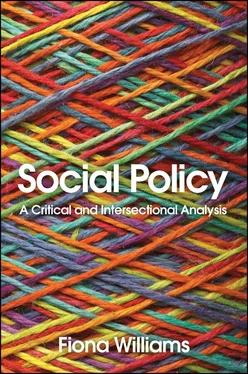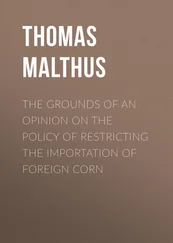The aim of this chapter has been to set out my broad analytical approach and influences. This may be summed up as an intersectionally informed critical approach. In the journey to this point, the chapter looked first at the ebbs and flows in the influence of critical thinking that originally emerged from new social movements on the core theories of social policy since the 1990s. This offered an interpretation of multiple contradictory dynamics involved in its (re)marginalization, which came not only from within the discipline but also from social, economic, political and intellectual developments over that time. These included the shift within neoliberalism to minimize advances in equality by focusing on delivering social justice through labour market activation and on a political era that saw itself as post-feminist and post-racial. This was also accompanied by the relative fragmentation not simply of those activisms but in their greater specialization and partition within the academy. The upsurge in social movement activism since 2008 in the face of the rise of popular nationalist right-wing politics provides one impelling reason for thinking through how to give these critical analyses greater consolidation in reflecting on the present and the future for welfare states.
In these terms, the chapter considered the relevance of intersectionality as an approach that, on the one hand, combines theory, method and political practice and, on the other, is highly attuned to inequalities and power around race, gender, disability, sexuality and class. I argued that intersectionality’s focus on lived experience, on understanding the complex and multiple nature of contestations, social inequalities and social justice, is crucial. It enables hidden injustices to be unfolded and provides an understanding of the relationship between commonalities and specificities and their link to political practices – all extremely relevant to critical social policy approaches. At the same time, as a relatively loose approach, it is necessary to be aware of problems in its application as well as its potential for social policy analysis. In order to mitigate these I turned to key analytical insights from critical thinking in social policy which in some ways are shared with an intersectional approach. These include the importance of contestation, in particular, but also of context, contingency, contradiction and criticality. Together the two approaches can clarify the connections between social, cultural, political and economic injustices to examine the nature of neoliberal welfare states within a political economy of global financialized capitalism which is extractivist, patriarchal and racializing. This requires a frame of analysis that avoids reductionism to single causes or monolithic conspiracy and allows for its contradictory nature. Chapter 3takes this up.
1 1. This is a summary of the analysis in Williams (1989) and was shaped by the different feminist and anti-racist writings of the time referenced in that book.
2 2. This is not the case in Capital and Ideology (Piketty 2020), where the history of slavery is seen as central to capitalism’s development.
3 3. For a more developed discussion see Nash (2019).
4 4. This podcast and video explain this more fully: www.kingsfund.org.uk/audio-video/podcast/covid-19-racism-health-inequality; www.thebritishacademy.ac.uk/events/british-academy-10-minute-talks-covid-19-and-inequalities/.
3 Intersecting Global Crises and Dynamics of Family, Nation, Work and Nature: A Framework for Analysis
Introduction
This chapter translates the discussion in chapter 2on intersectionality and critical approaches to social policy into a framework for analysing contemporary neoliberal welfare states. It seeks to take account of and go beyond those accounts that locate the forces behind austerity welfare solely within the contradictions of capitalism and neoliberal ideologies. The aim is to provide a way of analysing a more complex picture of the social formations and relations of power and inequality constituted through social policies in the twenty-first century. There are two dimensions to this framing: the first encapsulates the contradictions of global financial, patriarchal, racial and ecological capitalism and their associated crises. These include not only the North Atlantic Financial Crisis of 2008 but also the related and intersecting current global crises of the environment and climate change, of care and social reproduction, and of the racializing of transnational borders. The chapter spells out the different ways in which each of these crises threatens human and planetary wellbeing and sustainability. Also significant are the impacts they have, singly and together, in reproducing existing gender, class, racial and geo-political inequalities in even more stark ways. The second dimension of framing elicits an understanding of how welfare states at national scale attempt to ‘settle’ the changes and challenges around the intersections of family, nation, work and nature. While these two dimensions of the framework are spatially different – the first at global scale, the second at national scale – these spaces are not separate but interconnected. 1For example, the racialization of transnational borders is a global phenomenon but operationalized by national and supranational laws and practices. The framework presents a (national) frame within a (global) frame (see figure 3.1, p. 54). This framing is relevant to developed welfare states; here my detailed points of reference are to the UK. Before explaining these two dimensions I summarize some of the main shifts in welfare settlements in recent history.
Neoliberalism, welfare and austerity
Since the 1990s, most governments in developed countries have, to a greater or lesser extent, implemented neoliberal market principles in their welfare states. In general terms this has involved privatization, marketization, consumerism, labour market activation and individual responsibility, especially of self-support through paid work. It has generated the creation of markets and quasi-markets within public services, contracting out services to the private and voluntary (third) sector, and establishing partnerships with these sectors to deliver services. Welfare infrastructure, institutions and governance were reorganized according to new public management principles based on corporate business practice and the normalization of economy and competitiveness as serving efficiency and innovation. In its turn, this development has sought to construct service-users as consumers shopping wisely in the marketplace of health, personalized social care, welfare and education, while aligning services and benefits to the needs and requirements of the labour market and, more broadly, to competitiveness in a globalized economy.
The implementation and success of these principles and practices have varied across welfare states, as has the extent to which they replaced the post-war Keynesian welfare state model (Hall and Soskice 2001; Mandel and Shalev 2009). The earlier post-war model invested in mass state welfare in the broadest sense – health, education, income support, housing and social services – as a way of stimulating the economy, providing employment and enhancing profits and productivity, supported by a three-way consensus from organized labour, capital and the state. This was challenged from different quarters – socially, fiscally, organizationally and politically (O’Connor 1973; Gough 1979, Williams 1989). In the UK, Margaret Thatcher’s New Right monetarist policies of ‘markets, managers and a mixed economy’ was an early attempt from 1979 at implementing neoliberal and neoconservative welfare policies, in common with the US under Ronald Reagan. Similar changes happened later in Australia, Canada, New Zealand, Ireland, Iceland and Latin America, not only from right-wing but also from centre-left governments. However, neoliberalism has not been all of a piece. For example, neoliberal welfare, while changing its internal organization, has also encompassed key elements of the post-war welfare state into its practices (such as the NHS in the UK) in recognition of some of its popular support (Newman and Clarke 2009). It also demonstrates variety over time and place. Bob Jessop distinguishes the above-mentioned countries’ forms of economic neoliberalism from at least three other types: those that developed in post-communist countries after 1989; those imposed on developing countries through structural adjustment policies; and those implemented by some Northern European and Nordic countries with strong social democratic welfare histories (Jessop 2015). Although they are not included in Jessop’s categories, the East Asian countries of South Korea, Taiwan and Japan might fit more closely to the last category, though with a more nationalist emphasis (Peng and Wong 2008).
Читать дальше












